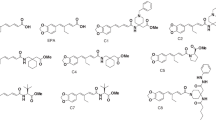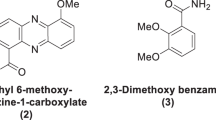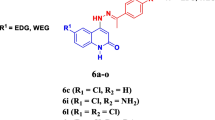Abstract
One approach to overcome the antimicrobial resistance of many pathogens is to associate compounds with antimicrobial properties and obtain combinations superior compared to the effect of each compound. To identify a possible potentiating effect, we tested and analyzed the inhibitory effect of the combination of coumarin with two pyrazole derivatives, 1,1′-methandiylbis (3,5-dimethyl-1H-pyrazole (AM4) and 3,5-dimethyl-1H-pyrazol-1-yl) methanol 3,5-dimethyl-1-hydroxymethylpyrazol (SAM4). A clear synergistic effect was recorded when coumarin was associated with SAM4, in which case the Fractional Inhibitory Concentration Index (FICI) had a value equal to 0.468 for Citrobacter freundii, Proteus mirabilis, and E. coli. In the other cases, however, both the association between coumarin and AM4 and coumarin SAM4 had only an additive effect (FICI = 0.937–1.00). The bactericidal effect of the coumarin–pyrazole combination over time was better in all cases compared to the effect of the compounds used separately. The viability of the bacterial cells at sub-inhibitory concentrations of the tested compounds was variable, depending on both the type of compound and the bacterial strain.



Similar content being viewed by others
Availability of data and materials
All data generated or analyzed during this study are included in this published article.
References
Ahn M, Gunasekaran P, Rajasekaran G, Kim EY, Lee SJ, Bang G, Kun C, Jae-Kyung H, Hyun-Ju L, Young HJ, Nam-Hyung K, Eun KR, Song YS, Jeong KB (2017) Pyrazole derived ultra-short antimicrobial peptidomimetics with potent anti-biofilm activity. Eur J Med Chem 125:551–564
Alexander HK, MacLean RC (2020) Stochastic bacterial population dynamics restrict the establishment of antibiotic resistance from single cells. PNAS 117(32):19455–19464
Al-Majedy YK, Kadhum AAH, Al-Amiery AA, Mohamad AB (2017) Coumarins: the antimicrobial agents. Syst Rev Pharm 8:62–70
Alnufaie R, Raj H, KC, Alsup N, Whitt J, Chambers SA, Gilmore D, Alam MA, (2020) Synthesis and antimicrobial studies of coumarin-substituted pyrazole derivatives as potent Anti-Staphylococcus aureus agents. Molecules 25(2758):1–16. https://doi.org/10.3390/molecules25122758
Basile A, Sorbo S, Spadaro V, Bruno M, Maggio A, Faraone N et al (2009) Antimicrobial and antioxidant activities of coumarins from the roots of Ferulago campestris (Apiaceae). Molecules 14(3):939–952
B’Bhatt H, Sharma S (2017) Synthesis and antimicrobial activity of pyrazole nucleus containing 2-thioxothiazolidin-4-one derivatives. Arabian J Chem 10:S1590–S1596. https://doi.org/10.1016/j.arabjc.2013.05.029
Braoudaki M, Hilton AC (2004) Adaptive resistance to biocides in Salmonella enterica and Escherichia coli O157 and cross-resistance to antimicrobial agents. J Clin Microbiol 42(1):73–78
Brockhurst MA, Harrison F, Veening JW, Harrison E, Blackwell G, Iqbal Z, Maclean C (2019) Assessing evolutionary risks of resistance for new antimicrobial therapies. Nat Ecol Evol 3:515–517
Buzon-Duran L, Alonso-Calleja C, Riesco-Pelaez F, Capita R (2017) Effect of sub-inhibitory concentrations of biocides on the architecture and viability of MRSA biofilms. Food Microbiol 65:294–301
Cattoir V, Felden B (2019) Future antibacterial strategies: from basic concepts to clinical challenges. J Infect Dis 220:350–360
Chavan RR, Hosamani KM (2018) Microwave-assisted synthesis, computational studies and antibacterial/anti-inflammatory activities of compounds based on coumarin–pyrazole hybrid. R Soc Open Sci 5:2–16. https://doi.org/10.1098/rsos.172435 (172435)
Diggle SP, Whiteley M (2020) Microbe Profile: Pseudomonas aeruginosa: opportunistic pathogen and lab rat. Microbiology 166(1):30–33. https://doi.org/10.1099/mic.0.000860
Domalaon R, Idowu T, Zhanel GG, Schweizer F (2018) Antibiotic hybrids: the next generation of agents and adjuvants against Gram-negative pathogens? Clin Microbiol Rev. https://doi.org/10.1128/CMR.00077-17
El-Seedi HR (2007) Antimicrobial arylcoumarins from Asphodelus microcarpus. J Nat Prod 70(1):118–120
Fadare FT, Adefisoye MA, Okoh AI (2020) Occurrence, identification, and antibiogram signatures of selected Enterobacteriaceae from Tsomo and Tyhume rivers in the Eastern Cape Province Republic of South Africa. PLoS ONE 15(12):e0238084. https://doi.org/10.1371/journal.pone.0238084
Geweely NS (2009) Novel inhibition of some pathogenic fungal and bacterial species by new synthetic phytochemical coumarin derivatives. Ann Microbiol 59(2):359–368
Girlich D, Bonnin RA, Dortet L, Naas T (2020) Genetics of acquired antibiotic resistance genes in Proteus spp. Front Microbiol 11:256. https://doi.org/10.3389/fmicb.2020.00256
Haddadin RNS, Saleh S, Al-Adham ISI, Collier BTEJ, PJ, (2010) The effect of subminimal inhibitory concentrations of antibiotics on virulence factors expressed by Staphylococcus aureus biofilms. J Appl Microbiol 108:1281–1291
Jain N, Jansone I, Obidenova T, Simanis R, Meisters J, Straupmane D, Reinis A (2021) Antimicrobial resistance in nosocomial isolates of Gram-negative bacteria: public health implications in the latvian context. Antibiotics 10:791. https://doi.org/10.3390/antibiotics10070791
Jung J-W, Kim N-J, Yun H, Han Y (2018) Recent advances in synthesis of 4-arylcoumarins. Molecules 23:2417. https://doi.org/10.3390/molecules23102417
Kumar S, Saini V, Maurya IK, Sindhu J, Kumari M, Kataria R et al (2018) Design, synthesis, DFT, docking studies and ADME prediction of some new coumarinyl linked pyrazolylthiazoles: Potential standalone or adjuvant antimicrobial agents. PLoS ONE 13(4):1–23. https://doi.org/10.1371/journal.pone.0196016 (e0196016)
Liu H, Ren Z-L, Wang W, Gong JX, Chu MJ, Ma QW, Wang JC, Lv X-H (2018) Novel coumarin–pyrazole carboxamide derivatives as potential topoisomerase II inhibitors: design, synthesis and antibacterial activity. Eur J Med Chem 157:81–87. https://doi.org/10.1016/j.ejmech.2018.07.059
Lupsor S, Aonofriesei F, Iovu M (2012) Antibacterial activity of aminals and hemiaminals of pyrazole and imidazole. Med Chem Res 21(10):3035–3042. https://doi.org/10.1007/s00044-011-9839-2
Lupsor S, Tarcomnicu I, Aonofriesei F, Iovu M (2011) Microwave-assisted synthesis of 1-hydroxymethylazoles. Rev Chim 62(5):493–498
Maertens H, Demeyere K, De Reu K et al (2020) Effect of subinhibitory exposure to quaternary ammonium compounds on the ciprofloxacin susceptibility of Escherichia coli strains in animal husbandry. BMC Microbiol 20:155. https://doi.org/10.1186/s12866-020-01818-3
Matos MJ, Vazquez-Rodriguez S, Fonseca A, Uriarte E, Santana L, Borges F (2017) Heterocyclic antioxidants in nature: coumarins. Curr Org Chem 21:311–324
Motyl M, Dorso K, Barret J, Giacobbe R (2005) Basic microbiological techniques for antibacterial drug discovery. Curr Protoc Pharmacol. https://doi.org/10.1002/0471141755.ph13a03s31
Narimisa N, Amraei F, Kalani BS, Mohammadzadeh R, Jazia FM (2020) Effects of sub-inhibitory concentrations of antibiotics and oxidative stress on the expression of type II toxin-antitoxin system genes in Klebsiella pneumoniae. J Glob Antimicrob Resist 21:51–56
Ojala T, Remes S, Haansuu P, Vuorela H, Hiltunen R, Haahtela K et al (2000) Antimicrobial activity of some coumarin containing herbal plants growing in Finland. J Ethnopharmacol 73(1–2):299–305
Pisano MB, Kumar A, Medda R, Gatto G, Pal R, Fais A, Era B, Cosentino S, Uriarte E, Santana L, Pintus F, Matos MJ (2019) Antibacterial activity and molecular docking studies of a selected series of hydroxy-3-arylcoumarins. Molecules 24(2815):1–12. https://doi.org/10.3390/molecules24152815
Sanhueza L, Melo R, Montero R, Maisey K, Mendoza L, Wilkens M (2017) Synergistic interactions between phenolic compounds identified in grape pomace extract with antibiotics of different classes against Staphylococcus aureus and Escherichia coli. PLoS ONE. https://doi.org/10.1371/journal.pone.0172273
Simoes NG, Bettencourt AF, Monge N, Ribeiro IAC (2017) Novel antibacterial agents: an emergent need to win the battle against infections. Mini Rev Med Chem 17:1364–1376
Singh AK, Das S, Kumar S, Gajamer VR, Najar IN, Lepcha YD, Tiwari HK, Singh S (2020) Distribution of antibiotic-resistant enterobacteriaceae pathogens in potable spring water of Eastern Indian Himalayas: emphasis on virulence gene and antibiotic resistance genes in Escherichia coli. Front Microbiol 11:581072. https://doi.org/10.3389/fmicb.2020.581072
Sindeldecker D, Stoodley P (2021) The many antibiotic resistance and tolerance strategies of Pseudomonas aeruginosa. Biofilm 3:100056. https://doi.org/10.1016/j.bioflm.2021.100056
Soumet C, Méheust D, Pissavin C, Le Grandois P, Frémaux B, Freurer C et al (2016) Reduced susceptibilities to biocides and resistance to antibiotics in food associated bacteria following exposure to quaternary ammonium compounds. J Appl Microbiol 121:1275–1281
Souza S, Delle Monache MF, Smania A (2005) Antibacterial activity of coumarins. Z Naturforsch 60c:693–700
Stanciu G, Aonofriesei F, Cristache N, Lupsor S (2017) Quantitative analysis and antibacterial activity of some coumarins extracts. Rev Chim 68(8):1752–1756
Sun J, Ding W-X, Hong X-P, Zhang K-Y, Zou Y (2012) Synthesis and antimicrobial activities of 4-aryl-3,4-dihydrocoumarins and 4-arylcoumarins. Chem Nat Compd 48:16–22
Tan N, Bilgin M, Tan E, Miski M (2017) Antibacterial activities of pyrenylated coumarins from the roots of Prangos hulusii. Molecules 22(7):1098
Veselinović JB, Veselinović AM, Nikolić GM, Pešic SZ, Stojanović DB, Matejić JS, Mihajilov-Krstev TM (2014) Antibacterial potential of selected 4-phenyl hydroxycoumarins: integrated in vitro and molecular docking studies. Med Chem Res 24:1626–1634
Whitt J, Duke C, Sumlin A, Chambers SA, Alnufaie R, Gilmore D, Fite T, Basnakian AG, Alam MA (2019a) Synthesis of hydrazone derivatives of 4-[4-Formyl-3-(2-oxochromen-3-yl)pyrazol-1-yl] benzoic acid as potent growth inhibitors of antibiotic-resistant Staphylococcus aureus and Acinetobacter baumannii. Molecules 24:2051. https://doi.org/10.3390/molecules24112051
Whitt J, Duke C, Ali MA, Chambers SA, Khan MMK, Gilmore D, Alam MA (2019b) Synthesis and antimicrobial studies of 4-[3-(3-Fluorophenyl)-4-formyl-1H-pyrazol-1-yl] benzoic acid and 4-[3-(4-Fluorophenyl)-4-formyl-1H-pyrazol-1-yl] benzoic acid as potent growth inhibitors of drug-resistant bacteria. ACS Omega 4:14284–14293
Wojnicz D, Tichaczek-Goska D (2013) Effect of sub-minimum inhibitory concentrations of ciprofloxacin, amikacin and colistin on biofilm formation and virulence factors of Escherichia coli planktonic and biofilm forms isolated from human urine. Braz J Microbiol 44(1):259–265
Zakeyah AA, Whitt J, Duke C, Gilmore DF, Meeker DG, Smeltzer MS, Alam MA (2018) Synthesis and antimicrobial studies of hydrazone derivatives of 4-[3-(2,4-difluorophenyl)-4-formyl-1H-pyrazol-1-yl]benzoic acid and 4-[3-(3,4-difluorophenyl)-4-formyl-1H-pyrazol-1-yl]benzoic acid. Bioorg Med Chem Lett 28:2914–2919
Zhanel GG, Hoban DJ, Harding GKM (1992) Subinhibitory antimicrobial concentrations: a review of in vitro and in vivo data. Can J Infect Dis 3(4):193–201
Acknowledgements
Author wish to thank Dr. Simona Lupsor, Faculty of Applied Sciences and Engineering for providing the chemicals necessary for experimentation.
Funding
Funding information is not applicable/no funding was received.
Author information
Authors and Affiliations
Contributions
FA designed, experimented, drafted, and wrote the article. FA is an Associate Professor of Microbiology, Faculty of Natural and Agricultural Sciences, Ovidius University of Constanta, Romania. He works mainly on the antimicrobial activity of natural and synthetic compounds against opportunistic and pathogenic bacteria and fungi.
Corresponding author
Ethics declarations
Competing interest
The author declares that he does not have any conflict of interest.
Ethics approval
Not applicable.
Consent to participate
Not applicable.
Consent for publication
Not applicable.
Additional information
Communicated by Erko Stackebrandt.
Publisher's Note
Springer Nature remains neutral with regard to jurisdictional claims in published maps and institutional affiliations.
Rights and permissions
About this article
Cite this article
Aonofriesei, F. Effect of methylpyrazoles and coumarin association on the growth of Gram-negative bacteria. Arch Microbiol 204, 160 (2022). https://doi.org/10.1007/s00203-022-02773-5
Received:
Revised:
Accepted:
Published:
DOI: https://doi.org/10.1007/s00203-022-02773-5




